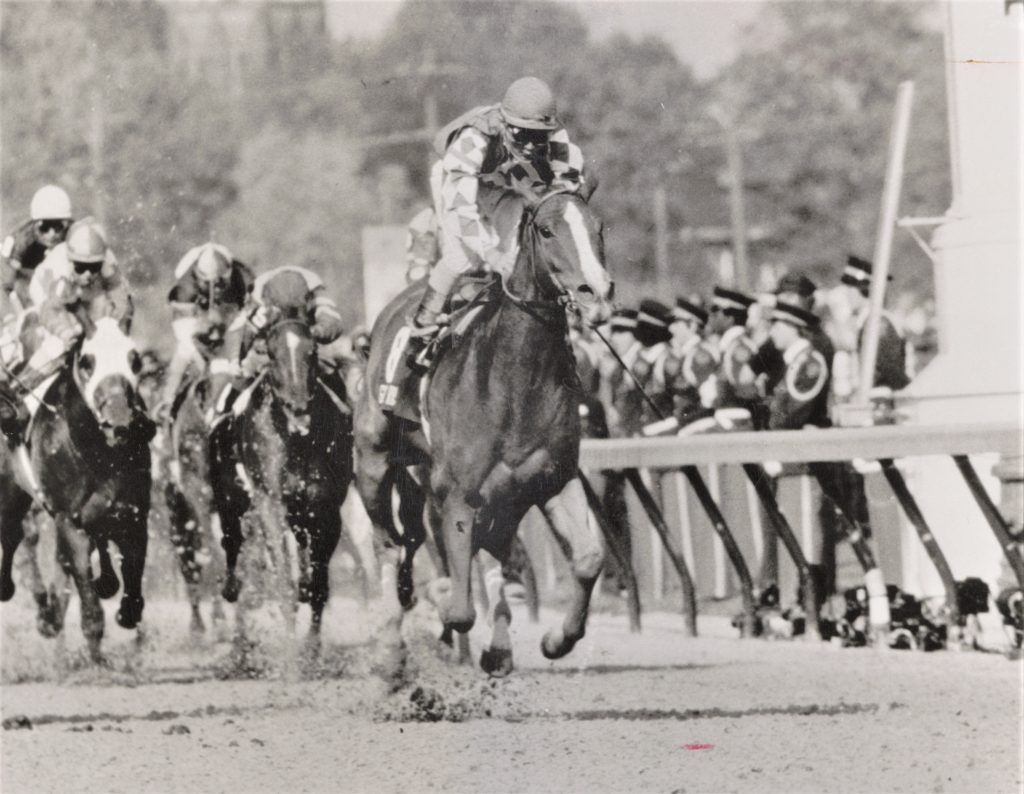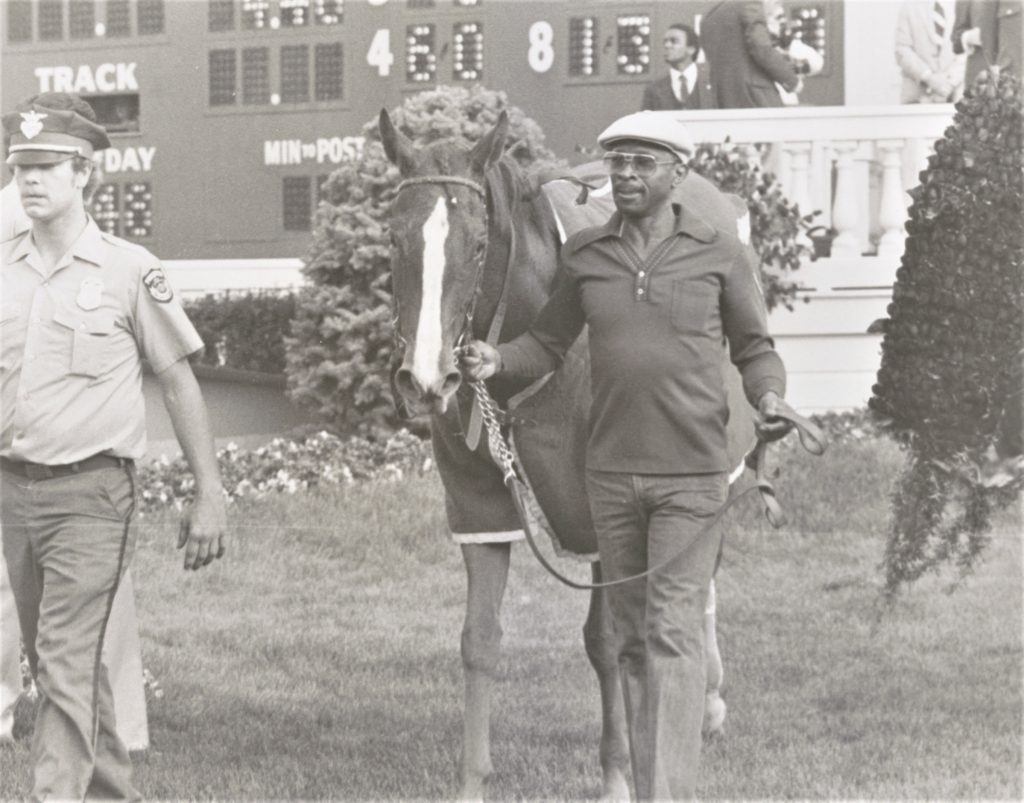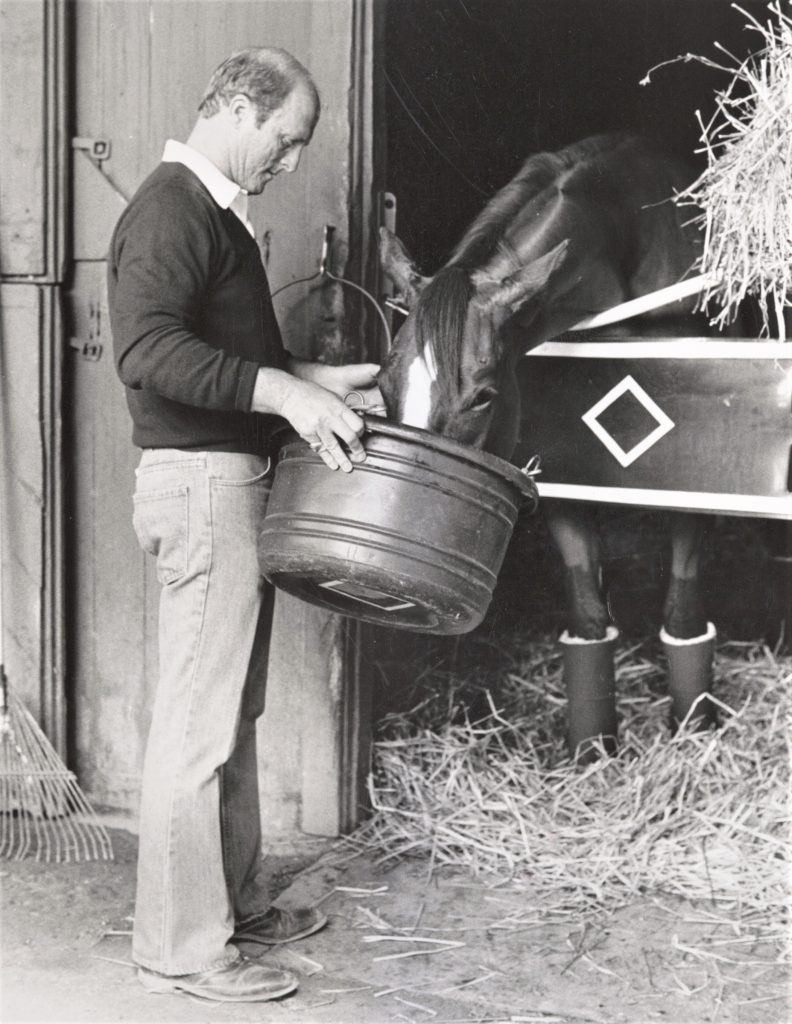
Keeneland Library Featherston Collection- Genuine Risk
The Kentucky Derby stands as America’s most celebrated race, an event that even people who do not regularly go to a racetrack or watch horse racing tune into and enjoy. The image of lovely red roses and the Twin Spires of Churchill Downs accompany names burned into our consciousness: Secretariat, American Pharoah, Justify. Everyone enters the sport dreaming of being there, watching the spectacle, and maybe even holding up that golden trophy in triumph. With 145 editions of the race behind us, a handful stands out as iconic, their names instantly recognizable. For March, as we celebrate Women’s History Month, I wanted to profile one of those iconic names, a filly who bested the boys for the title of Kentucky Derby winner: Genuine Risk.
Building Blocks
What does it take to build a filly like Genuine Risk, one that could run with the colts? First, find the right sire to imbue speed and grit, a stallion like Exclusive Native and then a dam deep in classic pedigree, a mare like Virtuous. A winner of the Sanford Stakes and the Arlington Classic, Exclusive Native showed speed early and ran with determination when in company, not afraid of confrontation. Additionally, his sire Raise a Native had sired Majestic Prince, dual classic winner in 1969; Mr. Prospector, who would rapidly become an influential sire of sires; and Alydar, outstanding racehorse and sire and rival to Affirmed, 1978 Triple Crown winner and a son of Exclusive Native.
Bred in Kentucky, Virtuous raced in France before returning stateside to finish out her career. Unplaced in her lone American start, she was then sold in the 1975 Keeneland November sale to Sally Humphrey and Shawnee Farm, who bred her to Exclusive Native in 1976. Her sire was Gallant Man, winner of the 1957 Belmont Stakes in stakes record time and her grand dam was Auld Alliance, dam of 1959 Kentucky Derby champion Tomy Lee. Names like Nasrullah and Mahmoud appear in Virtuous’s pedigree as well, making Genuine Risk’s pedigree one deep in classic winners on both sides. However, given in the timing of the filly’s birth in 1977, Affirmed and Alydar were months away from the first of their many meetings and no one knew what a bargain both sire and dam would be when the yearling Genuine Risk was consigned to the Fasig-Tipton yearling sale in July 1978.
A Special Girl
In some families, a love for horses goes as deep as the bonds between the people in them. When real estate developer Bertram Firestone married Diana Johnson, they created such a legacy, taking their fortunes and years of experience in the horse show world to the racetrack. By the end of the 1970s, they had two Kentucky Derby runners-up, General Assembly and Honest Pleasure, and a champion sprinter in the filly What a Summer. Matt Firestone, one of Bertram’s children from his previous marriage, also enjoyed equine pursuits like eventing, but also found himself bitten by the racing bug, learning about the business of thoroughbreds from an early age. The Firestones had picked several yearlings from that 1978 Fasig-Tipton catalog to inspect before the sale, but Matt noticed that they had missed one, a filly by Exclusive Native out of Virtuous.
Affirmed had outlasted Alydar to win the Triple Crown the month before so Exclusive Native was a name already on buyers’ mind when the catalog came out. Matt spotted the filly, noting that his father seemed to have missed her when he made his list. They were able to inspect her prior to the sale and the young Firestone, all of fourteen years old, bid on Exclusive Native filly to the tune of $32,000 when all was said and done. They named her Genuine Risk and sent her to the stable of trainer LeRoy Jolley.
Genuine Risk was one of several good fillies that Jolley had in his barn, but she showed what she was really made of in a workout prior to her first race. Under her exercise rider John Nazareth, the filly ran five furlongs in: 58 4/5, prompting Jolley to remark “I knew then that she was going to be a good one.”
Her first two starts were a study in how she would handle a variety of racetrack conditions. In her first start, she ran six and a half furlongs over a sloppy Belmont track, breaking slow but steadily picking off competitors as she moved up to win by three and a quarter lengths. A little over two weeks later, over a fast track at Aqueduct, Genuine Risk seemed to be in her element, getting off to a fast start, challenging the front runner, and then eventually grabbing the lead and pulling away to win by seven and a quarter lengths over the other five fillies in the race. With only two starts behind her, Jolley realized that his filly was game for a challenge: a stakes race. He entered her in the one-mile Tempted Stakes at Aqueduct.
She broke toward the middle of the field of nine, content to hang out in fifth behind the front runners until they hit the stretch. Jacinto Vasquez, the jockey who had been aboard her for each of her starts, moved her past tiring horses to take command and win by three lengths. Genuine Risk was so impressive in her performance in only her third start that Vasquez commented to Diana Firestone that the filly could beat the boys if they wanted to try. That would have to wait until the following year, though. Jolley opted to send Genuine Risk to the Demoiselle Stakes at a mile and an eighth. Whether she stayed with the fillies or tried the colts, the chestnut filly needed to be able to stretch out to at least that distance.
In the Demoiselle, though, loomed the toughest competition Genuine Risk would face that year, Smart Angle, who had already won multiple Grade I stakes that year. A candidate for the year’s Eclipse Award for two-year-old filly, Smart Angle would push Genuine Risk farther than she ever had before. The question was, could the daughter of Exclusive Native hold up under the pressure?
With Jacinto Vasquez on the outs with Jolley, Laffit Pincay Jr. was in the saddle for the Demoiselle and found Genuine Risk to be a willing partner in their battle with the field of seven. At the break, Smart Angle went straight to the rail and allowed Tash and Spruce Pine to run toward the front. Breaking from the sixth post, Pincay guided the filly to sit behind the leaders, to the right of the favorite Smart Angle. On the far turn, all Pincay needed to do was give Genuine Risk the cue and she moved past the front runners to take the lead. Initially boxed in by Genuine Risk, Smart Angle, though, had to move from the rail to the outside to get around the fading Tash and Spruce Pine. That bit of ground she lost was enough to keep Genuine Risk on top. Despite Smart Angle’s stretch drive, finally able to stride out and shrink the ground between her and the Firestone’s filly, Genuine Risk was able to hold her own as they dueled, calling on that grit she inherited from her sire. At the wire, the chestnut filly had a nose advantage over Smart Angle. It was enough to win her fourth start in a row, but not enough to take home the Eclipse Award for 1979. That went to Smart Angle after all.
Classically Historic
Nominated for both the Kentucky Oaks and Derby, Genuine Risk had options for her May starts, but which race would it be? Her starts in March and April would determine the filly’s path; the Firestones wanted the Derby, but Jolley worried preparing for a race like that would ask too much of the filly too soon. No filly had even run in the Kentucky Derby since 1959 and no filly had won it since Regret in 1915. Victories in her first two starts of the year showed that the filly had maintained her form over the winter. She carried 124 pounds, more than she would carry in the Derby, and won by two and a quarter lengths over other fillies. Her next test would give her experience against colts, familiarity she would need for the Run for the Roses.
In the Wood Memorial, she faced eleven colts, including the favorite Plugged Nickle, all horses that she might see again in Louisville. Genuine Risk carried 121 pounds versus the boys’ 126, the same weight she would carry in the Derby. Jolley still was not on board with running his filly in the Wood Memorial so he made the post draw the deciding factor: if she drew inside, she could stay in the race. She drew post position three and got her chance to finally face the boys and show them all what she was made of.
Running third for most of the race, she made a run for the lead on the far turn and stayed with the leaders, but was unable to gain ground on the eventual winner, Plugged Nickel. Her third place finish was the first defeat of her career, but she had finished only a length and a half behind the first two horses. The Firestones were determined to stay on a path to the Derby; Jolley reluctantly came along for the ride, initially stating that he had planned to save her for the Filly Triple Crown races in New York. When all of the Kentucky Derby prep races were said and done, no one colt had emerged as a threat to take the roses. If Genuine Risk wanted to take the chance, the roses might be hers for the picking. The Firestones were confident in their filly, and, as the race grew closer, Jolley saw that Genuine Risk continued to improve while her competition didn’t seem to be training as well. That feeling carried over to Derby Day itself as the horses were saddled for the 106th running of the Kentucky Derby.
“I wouldn’t try for the Derby if I didn’t think we had a chance,” Bert Firestone had told Sports Illustrated’s William Nack. As the field rounded the final turn at Churchill Downs, as the crash of more than 130,000 people cheering greeted their entrance into the stretch, Jacinto Vasquez urged Genuine Risk to pass Rockhill Native and Plugged Nickle and take the lead. She zipped past them, Vasquez switching to his left hand to tap her with his whip. As Genuine Risk worked to put space between her and the field, Rumbo and Jaklin Klugman threatened with late charges at the filly, but to no avail: Genuine Risk had won the Kentucky Derby by one length, only the second filly in history to beat her male peers and wear the blanket of roses. Five years before, Jacinto Vasquez had been riding Ruffian when she broke down in a match race with Foolish Pleasure; LeRoy Jolley was Foolish Pleasure’s trainer. The trauma of Ruffian’s sudden injury and subsequent death haunted both, but being a part of Genuine Risk’s victory in the Kentucky Derby hopefully alleviated some of the lingering sadness.

“This image is protected by copyright and may not be reproduced in print or electronically without written permission of the Keeneland Library.”
For Matt Firestone, the filly’s victory vindicated every instinct he had about her two years earlier at the Fasig-Tipton yearling sale. For Jacinto Vasquez, who had been advocating for Genuine Risk to meet the boys since early in her two-year-old year, her win proved that the Panamanian jockey had great instincts when it came to the potential inherent the daughter of Exclusive Native.
Controversy in Baltimore
John Nerud had already retired from training by the time Genuine Risk won the Derby in May 1980, over two decades after campaigning her damsire Gallant Man to win the Belmont and Travers Stakes in 1957. While Genuine Risk was preparing for the Derby on the East Coast, Nerud’s colt Codex was out in California, winning both the Hollywood Derby and the Santa Anita Derby, two major Derby preps. Nerud had declined to nominate Codex for the Run for the Roses, but the colt’s trainer D. Wayne Lukas nominated several horses for the Preakness and the Belmont Stakes – including Codex. The chestnut son of Arts and Letters, spoiler to Majestic Prince’s Triple Crown run in 1969, came east to face the Kentucky Derby winner along with six others.
The Firestones were ecstatic to send Genuine Risk to Baltimore as the Kentucky Derby winner, eager to prove that her victor was no fluke. She arrived as the morning line favorite, with fan mail pouring in from across the country. The filly had won many hearts with her performance in Louisville, which would make what would happen in the Preakness Stakes all the more controversial.
Angel Cordero, Jr., Codex’s jockey, had a reputation for aggression both on the racetrack and off, accused of everything from bullying to skirting the rules. Jacinto Vasquez on Genuine Risk found himself on the receiving end of Cordero’s aggressive nature: rounding the final turn at Pimlico, the filly made her move for the lead and hooked up with Codex for a few strides. As they came out of the turn, Cordero and Codex had drifted away from the rail toward the center of the track, taking Genuine Risk with them. It looked like Codex had brushed the filly enough as they ran together that it knocked her off stride. Unable to keep up with Codex in the stretch, the filly finished second, four and three-quarters length behind the winner.
Vasquez waited for the stewards to post an inquiry, insisting that Cordero and Codex had interfered with them coming out of the turn. When the inquiry sign didn’t go up, Vasquez claimed a foul that the stewards soon dismissed, upholding the results of the Preakness. The Firestones, infuriated by what they felt was a lapse in judgement by the Pimlico stewards, appealed the stewards’ decision to the Maryland Racing Commission. After a three-day hearing with testimony from everyone involved with the race, including the jockeys and trainers, the Commission upheld the stewards’ decision. Disappointed, the Firestones opted not to pursue the matter further.
The Lady Is a Champ
Genuine Risk went on to the Belmont Stakes, where her rematch with Codex fizzled into a romp for newcomer Temperance Hill. The filly finished second, making her the first Kentucky Derby-winning filly to run in all three of the Triple Crown races. Jolley gave her time off after the classics were done, waiting until September to run her in the Maskette Stakes and then the Ruffian Handicap, where she finished 1980 with a victory. Her performances that year were rewarded with the Eclipse Award for Champion Three-Year-Old Filly.
In 1981, at age four, Genuine Risk ran three times, winning two. The Firestones had intended to point her to the Woodward Stakes and then the Marlboro Cup in September. After a workout at Belmont in early September, the filly escaped her hotwalker and ran into a fire hydrant, injuring her knee. While the injury wasn’t serious, the Firestones felt that she had done more than enough on the racetrack and decided to retire her to her next career. As a broodmare, her first mating with Secretariat resulted in a stillborn chestnut colt; her second mating with the 1973 Triple Crown winner was unsuccessful. Despite being bred to a number of famous stallions, Genuine Risk had genuine difficulty carrying a foal to term. When she finally did have a live foal in 1993, the Firestones named the colt Genuine Reward. Later, in 1996, Genuine Risk foaled Count Our Blessing, her last live foal. She was officially retired from broodmare duty in 2000, at the age of 23.
Winning Colors joined the exclusive club of Derby-winning fillies in 1988, but Genuine Risk still holds the record for the best performances of a filly in the Triple Crown classics, with her win and two seconds. Despite her difficulties as a broodmare, Genuine Risk remained a popular figure in horse racing long after her career was over, especially as she experienced difficulties as a broodmare. In 2008, Genuine Risk passed away at the Firestones’s Newstead Farm in Virginia, where she had spent her last days running around her paddock as the farm’s resident queen. Though she’s gone, her historic feat of beating the boys at their own game in the Kentucky Derby, the country’s greatest race, lives on, an inspiration to anyone, male or female, with the heart and the courage to take on a challenge and beat it.

“This image is protected by copyright and may not be reproduced in print or electronically without written permission of the Keeneland Library.”



